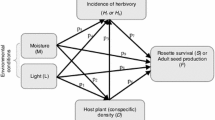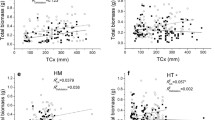Abstract
The Evolution of Increased Competitive Ability (EICA) hypothesis proposes that exotic plants may become superior competitors in their introduced ranges because they have evolved reduced defense allocation and increased growth in response to low herbivory. Long-term common garden studies with Chinese tallow tree (Sapium sebiferum), a problematic invader in the southeastern United States, support EICA predictions of invasive ecotypes displaying rapid growth with poorly defended leaves, whereas native ecotypes are slower growing and have nitrogen rich, highly defended leaves. We conducted two full-factorial experiments designed to assess the effects of leaf herbivory and soil fertility on growth of Sapium seedlings derived from seeds obtained in the speciesȁ9 native Chinese range and introduced range along the Texas Gulf Coast. The first was a field study employing simulated defoliation to examine herbivory tolerance, while the second was a pot study using grasshopper bioassays to measure the compensatory regrowth of native and introduced Sapium ecotypes. In accordance with EICA predictions, introduced Texas ecotypes compensated for mechanical and natural defoliation regardless of resource conditions while growth of native Chinese ecotypes was significantly reduced as a result of both simulated and natural herbivory damage. These results demonstrate that invasive Sapium ecotypes have a greater capacity to compensate for herbivory damage than native Sapium ecotypes. The differences between Sapium ecotypes are consistent with the mechanisms of EICA and other findings demonstrating that invasive ecotypes have become herbivory tolerant due to post-introduction changes in tissue quality.
Similar content being viewed by others
References
A.A. Agrawal (2000) ArticleTitleBenefits and costs of induced plant defense for Lepidium Virginicum (Brassicaceae) Ecology 81 1804–1813
P. Alpert E.L. Simms (2002) ArticleTitleThe relative advantage of plasticity and fixity in different environments: when is it good for a plant to adjust? Evol. Ecol. 16 285–297 Occurrence Handle10.1023/A:1019684612767
I. Baldwin (1998) ArticleTitleJasmonate-induced responses are costly but benefit plants under attack in native populations Proc. Natl. Acad. Sci. USA 95 8113–8118 Occurrence Handle9653149 Occurrence Handle1:CAS:528:DyaK1cXks1Skurw%3D
H.G. Baker (1974) ArticleTitleThe evolution of weeds Annu. Rev. Ecol. Syst. 5 1–24 Occurrence Handle10.1146/annurev.es.05.110174.000245
F.A. Bazzaz N.R. Chiariello P.D. Coley L.F. Pitelka (1987) ArticleTitleAllocating resources to reproduction and defense BioScience 37 58–67
B. Blossey R. Nötzold (1995) ArticleTitleEvolution of increased competitive ability in invasive nonindigenous plants: a hypothesis J. Ecol. 83 887–889
O. Bossdorf S. Schröder D. Prati H. Auge (2004) ArticleTitlePalatability and tolerance to simulated herbivory in native and introduced populations of Alliaria petiolata (Brassicaceae) Am. J. Bot. 91 856–862
K.A. Bruce G.N. Cameron P.A. Harcombe G. Jubinsky (1997) ArticleTitleIntroduction, impact on native habitats, and management of a woody invaderthe Chinese Tallow TreeSapium sebiferum (L.) Roxb Nat. Areas J. 17 255–260
R.M. Callaway S.C. Pennings C.L. Richards (2003) ArticleTitlePhenotypic plasticity and interactions among plants Ecology 84 1115–1128
P.D. Coley J.P. Bryant F.S. Chapin (1985) ArticleTitleResource availability and plant antiherbivore defense Science 230 895–899
M.J. Crawley (1989) Chance and timing in biological invasions J.A. Drake H.A. Mooney F. di Castri R.H. Groves F.J. Kruger M. Rejmanek M.W. Williamson (Eds) Biological Invasions John Wiley and Sons New York 407–424
C. Daehler D.R. Strong (1997) ArticleTitleReduced herbivore resistance in introduced smooth cordgrass (Spartina alterniflora) after a century of herbivore-free growth Oecologia 110 99–108 Occurrence Handle10.1007/s004420050138
S.J. DeWalt J.S. Denslow K. Ickes (2004) ArticleTitleNatural enemy release facilitates habitat expansion of the invasive tropical shrub Clidemia hirta Ecology 85 471–483
C.S. Elton (1958) The Ecology of Invasion by Plants and Animals Chapman and Hall London
M. Fenner (1987) ArticleTitleSeedlings Can. J. Bot. 106 35–47
W.L. Fineblum M.D. Rausher (1995) ArticleTitleTradeoff between resistance and tolerance to herbivore damage in a morning glory Nature 377 517–520 Occurrence Handle10.1038/377517a0 Occurrence Handle1:CAS:528:DyaK2MXoslWlsbo%3D
S.D. Hendrix (1988) Herbivory and its impact on plant reproduction J. Lovett-Doust L. Lovett-Doust (Eds) Plant Reproductive Ecology Oxford Press New York 246–263
D.A. Herms W.J. Mattson (1992) ArticleTitleThe dilemma of plants: to grow or to defend Quart. Rev. Biol. 67 283–335 Occurrence Handle10.1086/417659
E. Haukioja J. Koricheva (2000) ArticleTitleTolerance to herbivory in woody vs. herbaceous plants Evol. Ecol. 14 551–562 Occurrence Handle10.1023/A:1011091606022
G. Jubinsky L.C. Anderson (1996) ArticleTitleThe invasive potential of Chinese Tallow-tree (Sapium sebiferum Roxb.) in the southeast Castanea 61 226–231
R.M. Keane M.J. Crawley (2002) ArticleTitleExotic plant invasions and the enemy release hypothesis Trends Ecol. Evol. 17 164–170 Occurrence Handle10.1016/S0169-5347(02)02499-0
R.A. Lankau W.E. Rogers E. Siemann (2004) ArticleTitleConstraints on the utilization of the invasive Chinese Tallow Tree (Sapium sebiferum) by generalist native herbivores in coastal prairies Ecol. Entomol. 29 66–75 Occurrence Handle10.1111/j.0307-6946.2004.00575.x
K. Lehtila (2003) ArticleTitlePrecision of herbivore tolerance experiments with imposed and natural damage Evolution 57 677–680 Occurrence Handle12703957
R.N. Mack D. Simberloff W.M. Lonsdale H. Evans M. Clout F.A. Bazzaz (2000) ArticleTitleBiotic invasions: causes, epidemiology, global consequences, and control Ecol. Appl. 10 689–710
R.J. Marquis (1992) The selective impact of herbivores R.S. Fritz E.L. Simms (Eds) Plant Resistance to Herbivores and Pathogens: Ecology, Evolution, and Genetics University of Chicago Press Chicago 301–325
J.L. Maron M. Vila (2001) ArticleTitleWhen do herbivores affect plant invasion? Evidence for the natural enemies and biotic resistance hypotheses Oikos 95 361–373 Occurrence Handle10.1034/j.1600-0706.2001.950301.x
J. Maschinski T. Whitham (1989) ArticleTitleThe continuum of plant responses to herbivory: the influence of plant association, nutrient availability and timing Am. Natural. 134 1–19
R. Mauricio (1998) ArticleTitleCosts of resistance to natural enemies in field populations of the annual plant Arabidopsis thaliana Am. Natural. 151 20–28
R. Mauricio (2000) ArticleTitleNatural selsection and the joint evolution of tolerance and resistance as plant defenses Evol. Ecol. 14 491–507 Occurrence Handle10.1023/A:1010909829269
S.J. Meiners S.N. Handel (2000) ArticleTitleAdditive and nonadditive effects of herbivory and competition on tree seedling mortality, growthand allocation Am. J. Bot. 87 1821–1826 Occurrence Handle11118420
C.E. Mitchell A.G. Power (2003) ArticleTitleRelease of invasive plants from fungal and viral pathogens Nature 421 625–627 Occurrence Handle10.1038/nature01317 Occurrence Handle12571594 Occurrence Handle1:CAS:528:DC%2BD3sXovFKnsQ%3D%3D
P. Mitchell W. Arthur M. Farrow (1992) ArticleTitleAn investigation of population limitation using factorial experiments Ecology 61 591–598
H.A. Mooney E.E. Cleland (2001) ArticleTitleThe evolutionary impact of invasive species Proc. Natl. Acad. Sci. USA 98 5446–5451 Occurrence Handle11344292 Occurrence Handle1:CAS:528:DC%2BD3MXjs1Wgurw%3D
J.R. Obeso (1993) ArticleTitleDoes defoliation affect reproductive output in herbaceous perennials and woody plants in different ways? Funct. Ecol. 7 150–155
I.M. Parker J. Rodriguez M.E. Loik (2003) ArticleTitleAn evolutionary approach to understanding the biology of invasions: local adaptation and general-purpose genotypes in the weed Verbascum thapsus Conserv. Biol. 17 59–72 Occurrence Handle10.1046/j.1523-1739.2003.02019.x
D. Pilson (2000) ArticleTitleThe evolution of plant response to herbivory: simultaneously considering resistance and tolerance in Brassica rapa Evol. Ecol. 14 457–489 Occurrence Handle10.1023/A:1010953714344
W.E. Rogers S. Nijjer C.L. Smith E. Siemann (2000) ArticleTitleEffects of resources and herbivory on leaf morphology and physiology of Chinese tallow (Sapium sebiferum) tree seedlings Tex. J. Sci. 52S 43–56
W.E. Rogers E. Siemann (2002) ArticleTitleEffects of simulated herbivory and resource availability on native and invasive exotic tree seedlings Basic Appl. Ecol. 3 297–307 Occurrence Handle10.1078/1439-1791-00120
W.E. Rogers E. Siemann (2003) ArticleTitleEffects of simulated herbivory and resources on Chinese tallow tree (Sapium sebiferumEuphorbiaceae) invasion of native coastal prairie Am. J. Bot. 90 243–249
W.E. Rogers E. Siemann (2004) ArticleTitleInvasive ecotypes tolerate herbivory more effectively than native ecotypes of the Chinese tallow tree J. Appl. Ecol. 41 561–570 Occurrence Handle10.1111/j.0021-8901.2004.00914.x
C.F. Sacchi E.F. Conner (1999) ArticleTitleChanges in reproduction and architecture in flowering dogwoodCornus floridaafter attack by dogwood club gall, Resseliella clavula Oikos 86 138–146
H.W. Scheld J.R. Cowles (1981) ArticleTitleWoody biomass potential of the Chinese Tallow Tree Econ. Bot. 35 391–397
K.A. Schierenbeck R.N. Mack R.R. Sharitz (1994) ArticleTitleEffects of herbivory on growth and biomass allocation in native and introduced species of Lonicera Ecology 75 1661–1672
J.P. Sexton J.K. McKay A. Sala (2002) ArticleTitlePlasticity and genetic diversity may allow saltcedar to invade cold climates in North America Ecol. Appl. 12 1652–1660
G.R. Shaver F.S. Chapin (1980) ArticleTitleResponse to fertilization by various plant growth forms in an Alaskan tundra: nutrient accumulation and growth Ecology 61 662–675 Occurrence Handle1:CAS:528:DyaL3cXls1Krtrk%3D
E. Siemann W.E. Rogers (2001) ArticleTitleGenetic differences in growth of an invasive tree species Ecol. Lett. 4 514–518 Occurrence Handle10.1046/j.1461-0248.2001.00274.x
E. Siemann W.E. Rogers (2003a) ArticleTitleHerbivory, diseaserecruitment limitation and the success of an alien tree species Ecology 84 1489–1505
E. Siemann W.E. Rogers (2003b) ArticleTitleReduced resistance of invasive varieties of the alien tree Sapium sebiferum to a generalist herbivore Oecologia 135 451–457
E. Siemann W.E. Rogers (2003c) ArticleTitleIncreased competitive ability of an invasive tree may be limited by an invasive beetle Ecol. Appl. 13 1503–1507
E.L. Simms (1992) Costs of plant resistance to herbivory R.S. Fritz E.L. Simms (Eds) Plant Resistance to Herbivores and Pathogens University of Chicago Press Chicago 392–425
K.A. Stowe R.J. Marquis C.G. Hochwender E.L. Simms (2000) ArticleTitleThe evolutionary ecology of tolerance to consumer damage Annu. Rev. Ecol. Syst. 31 565–595 Occurrence Handle10.1146/annurev.ecolsys.31.1.565
S.Y. Strauss J.A. Rudgers J.A. Lau R.E. Irwin (2002) ArticleTitleDirect and ecological costs of resistance to herbivory Trends Ecol. Evol. 17 278–285 Occurrence Handle10.1016/S0169-5347(02)02483-7
D.R. Strong J.H. Lawton T.R.E. Southwood (1984) Insects on Plants Harvard Press Cambridge
P. Tiffin B.D. Inouye (2000) ArticleTitleMeasuring tolerance to herbivory: accuracy and precision of estimates made using natural versus imposed damage Evolution 54 1024–1029 Occurrence Handle10937274 Occurrence Handle1:STN:280:DC%2BD3cvhvFOqtw%3D%3D
D. Tilman (1999) ArticleTitleThe ecological consequences of changes in biodiversity: a search for general principles Ecology 80 1455–1474
D.N. Ueckert R.M. Hansen (1971) ArticleTitleDietary overlap of grasshoppers on sandhill rangeland in northeastern Colorado Oecologia 8 276–295
E. van der Meijden M. Wijn H.J. Verkaar (1988) ArticleTitleDefence and regrowthalternative strategies in the struggle against herbivores Oikos 51 355–363
M. van Kleunen B. Schmid (2003) ArticleTitleNo evidence for an evolutionary increased competitive ability in an invasive plant Ecology 84 2816–2823
A. Weis E.L. Simms M. Hochberg (2000) ArticleTitleWill plant vigor and tolerance be genetically correlated? Effects of intrinsic growth rate and self-limitation on regrowth Evol. Ecol. 14 331–352 Occurrence Handle10.1023/A:1010950932468
A.J. Willis M. Thomas J. Lawton (1999) ArticleTitleIs the increased vigour of invasive weeds explained by a trade-off between growth and herbivore resistance? Oecologia 120 632–640 Occurrence Handle10.1007/s004420050899
J.L. Yela J.H. Lawton (1997) ArticleTitleInsect herbivore loads on native and introduced plants: a preliminary study Entomol. Exp. Appl. 85 275–279 Occurrence Handle10.1023/A:1003125930772
Author information
Authors and Affiliations
Corresponding author
Rights and permissions
About this article
Cite this article
Rogers, W., Siemann, E. Herbivory Tolerance and Compensatory Differences in Native and Invasive Ecotypes of Chinese Tallow Tree (Sapium sebiferum). Plant Ecol 181, 57–68 (2005). https://doi.org/10.1007/s11258-005-3029-6
Received:
Accepted:
Issue Date:
DOI: https://doi.org/10.1007/s11258-005-3029-6




